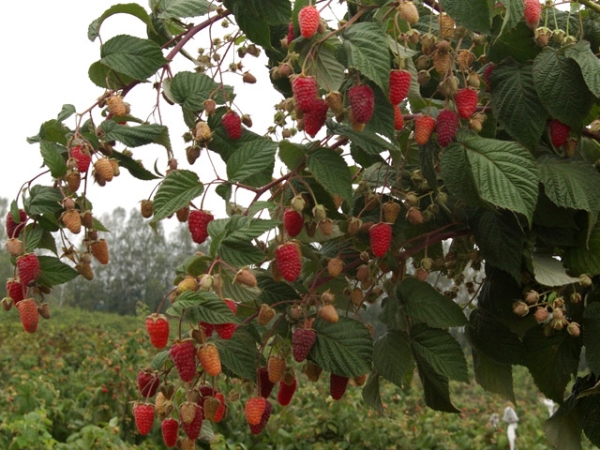Who in the garden plot or in the garden does not have this wonderful berry. Raspberries - berry tasty and healthy, it is characterized by healing properties, it is grown on a trellis (wooden supports between which the wire is stretched or the rail is nailed).
Breeders secrete four kinds of raspberry:
- Common raspberry.
- Large fruit.
- Remontnaya.
- Stambovaya.
Standard raspberry appeared at the end of the twentieth century in Russia. The first grade of Tarusa is registered in 1993. This type of raspberry has become popular and sought after by gardeners.
Table of contents
Characteristics of the raspberry stem
Standard raspberry popularly called raspberry, has a thick sturdy stem that allows you to grow it without the use of trellis.
On each side shoot shoots are formed, on which the berries grow round or elongated, weighing from 4-5 g to 12-18 g depending on the variety.
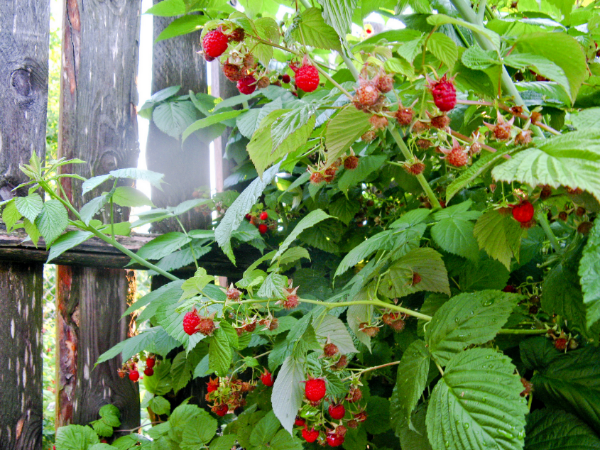
Where can I buy these cuttings
In nurseries, fruit and berry stations, and specialized farmswhere seedlings of cultivated varieties of fruit and berry crops are grown.
It should not be taken from random sellers, as a person who does not know does not distinguish between raspberry varieties.
Soil preparation for planting seedlings
Raspberries can be planted in spring and autumn. When planting the planting material in the fall, the place is prepared about two months before planting and it is advisable to plant either legumes, mustard or alfalfa on this site.
Herbs will enrich the soil with organic matter, and legumes with nitrogen and other trace elements.
Raspberry needs watering at the time when it blooms and when fruits are tied.
When choosing planting time in spring, the place is prepared in the fall. In spring, seedlings should be planted before budding, and in the fall, time is calculated so that the plants can harden before the start of frost.
When planting raspberries in the fall, spud at 12-15 centimeters, cover the lower buds so that they do not freeze.
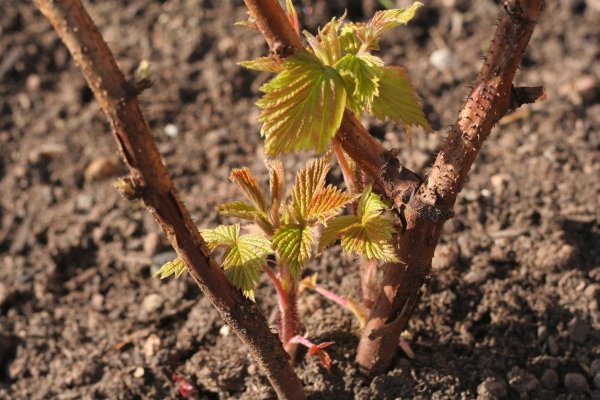
Landing
Plants are planted in two ways.:
- By the belt method, a trench is prepared in advance and organic and mineral fertilizers are introduced into it.
- Shrubs, pits are made at a distance of 50-70 cm from each other.
The distance between rows is 1.5 - 2.0 m, so that the cultivator can be used for plowing between rows, and each bush will receive more light.
Fertilizers are applied in the trench or in the pit for planting and covered with a layer of earth.
Seedlings roots are cut, are released from the damaged ones, then descend into a mash (infusion of a mullein or chicken droppings filled with clay) and spread on the ground.
The plant is poured with cooked earth and mulch around finely chopped straw manure.
Care
Standard raspberry, as well as ordinary, unpretentious plant, but if the purpose of planting was to get a big crop, then care of raspberry bushes is absolutely necessary.
After planting, after two weeks, the bushes are already strengthened, and begin to form a bush. The tip of the shoot pinch (it is cut off by 10-15 cm). After that, the lateral buds wake up and by the autumn a shrub of several shoots is formed.
In the first year, planted in the spring, raspberries do not give a big harvest.
You may be interested in these articles:
In the fall, cut out all the fruitful shoots and leave the young. Their spring is pruned as well as the first, and the branching of the secondary branches takes place. This bush can give from 4 to 12 kg of berries.
After trimming bushes must be treated with Bordeaux mixture. Although raspberry stem varieties are resistant to diseases, but prevention does not hurt, remove last year's foliage, plow the rows between rows and mulch the ground around the plants with humus.
Weeding loosens the soil and does not allow it to overheat.
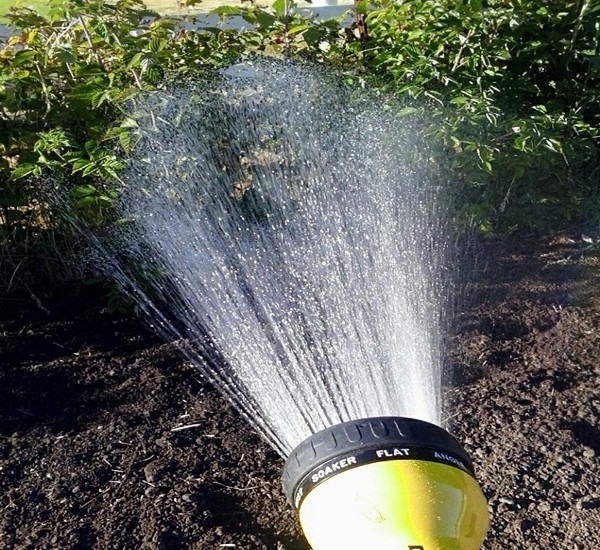
Watering, with dry spring, is carried out 1 time per week., 10 liters for each bush. When flowering and fruiting plants are demanding for watering, otherwise the raspberry drops the ovary and the resulting berries dry up.
At the time of formation of the ovaries, a second feeding is carried out with organic and inorganic fertilizers.
Autumn is the second treatment of plants from pests.. After such care, raspberries will delight with excellent harvest, large, juicy with a pleasant smell, berries.
Advantages and disadvantages of raspberry varieties
Saplings resembling young trees, possess qualities:
- Resistance to diseases.
- Frost resistance, tolerate frosts up to -30, but short-term.
- They also bear fruit at +30 air temperature in the shade, keeping all the taste qualities of the berries, and they need abundant watering.
- Differ in high productivity.
- The stems differ from the usual raspberries in that there are no thorns on them, it is easy and pleasant to pick the berries.
- Berries large from 4 cm to 18-20 cm well separated from the stem.
- Do not require a garter, which greatly simplifies the care of raspberry bushes of shtambovyh varieties.
Raspberry trees for the season give 10-12 branches of substitution and do not crawl around the site, which facilitates farming in areas with standard raspberry varieties.
And standard raspberry varieties are repairable, they begin to bear fruit in late July, early June, because of this, in central Russia, in Siberia, there is always a chance not to get a third of the crop, the berries will not have time to ripen and fall under frost.
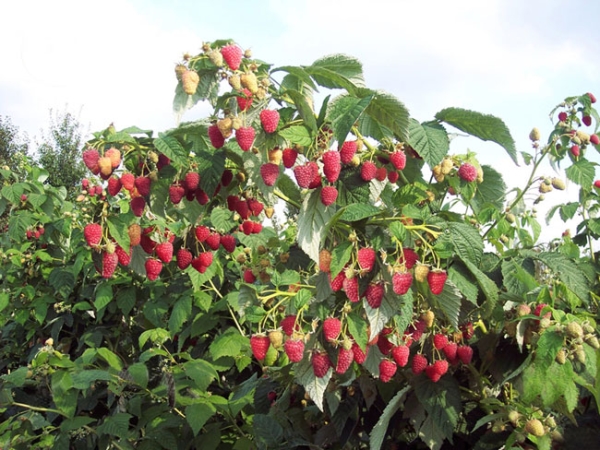
Sorta
To varieties of non-repair raspberrieswhich bears fruits from June to July in central Russia and in the south:
- Tarusa;
- Fairy tale;
- Burly;
- Galaxy and others
To remontant varieties Crimson trees include such varieties that have been bearing fruit since July until frost, these are:
- Penguin;
- Eurasia and others
Description of tree raspberry varieties
Tarusa
Tarusa - the first domestic variety of standard raspberry. It is most common among gardeners. The berries of this variety are large, conical, elongated, 4 - 12 g. Their weight is bright red with a pleasant smell.
The variety does not require pruning after the formation of the crown of the seedling, the roots do not spread out on the plot.The trees are resistant to diseases, has a high yield.
This variety can be grown almost all over Russia., although it is characterized by less frost resistance and requires bending of the bushes to the ground and their shelter with snow.
Burly
Berries large up to 10 cm, very tasty, fragrant. Sturdy fruits steadily regardless of fluctuations in external conditions. Gives many replacement stems, prone to overgrowing.
This variety is well propagated by cuttings. High-yielding, from a bush receive up to 4 kg of berries.
Fairy tale
The variety is frost resistant, resistant to diseasesand high-yielding. Up to 12 kg of berries are harvested from the bush, they tolerate transportation well, they do not crumple.
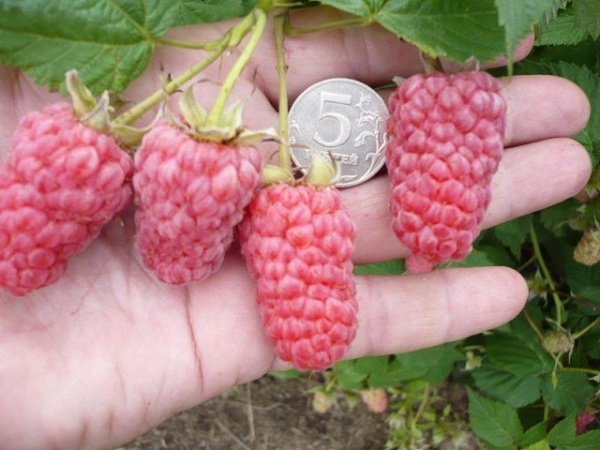
Penguin and Eurasia
Varieties Penguin and Eurasia are annual varieties. After fruiting, their shoots are cut almost to the ground. In this way, these varieties are preserved in the winter and in the spring they give new shoots from the root.
Have large berries fruits from late July to September,tasty and fragrant berries weighing 4-5 g.
Today there are a lot of varieties of standard raspberries, which allows to satisfy the tastes of most gardeners.
Raspberry trees with yellow and black berries appeared, this is for gourmets, and they become the decoration of garden plots.
Useful properties of berries
Raspberry berries are rich:
- glucose, sucrose and fructose;
- malic, citric and salicylic acids;
- vitamins A, C and B;
- minerals and salts;
- contain iron, zinc, copper, calcium;
- provitamin A.
Berries of yellow varieties contain a lot of carotene.

Raspberry with drugs indicated for diseases:
- these are colds, including the flu;
- used for gastritis;
- weakens a strong cough with sore throat;
- used in atherosclerosis;
- scurvy is conquered by vitamin C, which is abundant in raspberries;
- with anemia, there is a shortage of iron, which is contained in a sufficient amount of raspberries;
- used as a great antipyretic and diaphoretic in the form of drinking.
In the end, we note some interesting facts:
- One handful of raspberries improves mood and restores the nervous system after trouble.
- To cultivate raspberries on the plot began Plinyback in the days of ancient Rome. He tried a berry growing in the wild nature of the island of Crete and brought raspberry bush to the garden.
- The most useful type of raspberry is black.. It has the unique ability to strengthen the walls of blood vessels.
